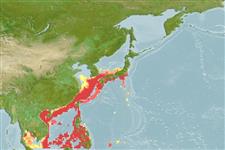Common names from other countries
Environment: milieu / climate zone / depth range / distribution range
Ecologie
; diepteverspreiding 49 - 314 m (Ref. 4), usually 100 - 250 m (Ref. 4). Tropical; 14°C - 24°C (Ref. 112711), preferred 24°C (Ref. 107945); 38°N - 6°N, 99°E - 142°E (Ref. 4)
Western Pacific.
Length at first maturity / Size / Gewicht / Leeftijd
Maturity: Lm ? range ? - ? cm Max length : 23.0 cm TL mannelijk/geslacht niet bekend; (Ref. 4)
It has a maximum total length of 23 cm; and a carapace length of 4 to 7.6 cm (male) and 4 to 8 cm (female), 6 to 8 cm (ovigerous female) (Ref. 4). Occurs at a depth range from 49 to 314 m, mostly between 100 and 250 m, and it is found on soft substrates of sand, mud or clay (Ref. 4). It prefers salinities of 34 ppt (Ref. 112711). Phyllosomas grow into juvenile stage with feeding on jellyfish under laboratory conditions. It is suggested that for genus Ibacus, jellyfish may be a viable diet for phyllosomas (Ref. 112087).
Life cycle and mating behavior
Geslachtsrijpheid | Voortplanting | Kuitschieten | Eieren | Fecundity | Larven
Members of the order Decapoda are mostly gonochoric. Mating behavior: Precopulatory courtship ritual is common (through olfactory and tactile cues); usually indirect sperm transfer.
Holthuis, L.B. 1991. (Ref. 4)
Status op de Rode Lijst van het IUCN (Ref. 130435)
Status bij CITES (Ref. 108899)
Not Evaluated
Not Evaluated
Gebruik door de mens
Visserij: commercieel
FAO - Visserij: landings | FishSource | Sea Around Us
Tools
Meer informatie
Leeftijd/Grootte
Groei
Lengte-gewicht parameters
Lengte-lengte parameters
Morfologie
Larven
Abundantie
Internet-bronnen
Estimates based on models
Preferred temperature
(Ref.
115969): 17.5 - 26.7, mean 21.1 (based on 214 cells).
Kwetsbaarheid
Low vulnerability (13 of 100).
